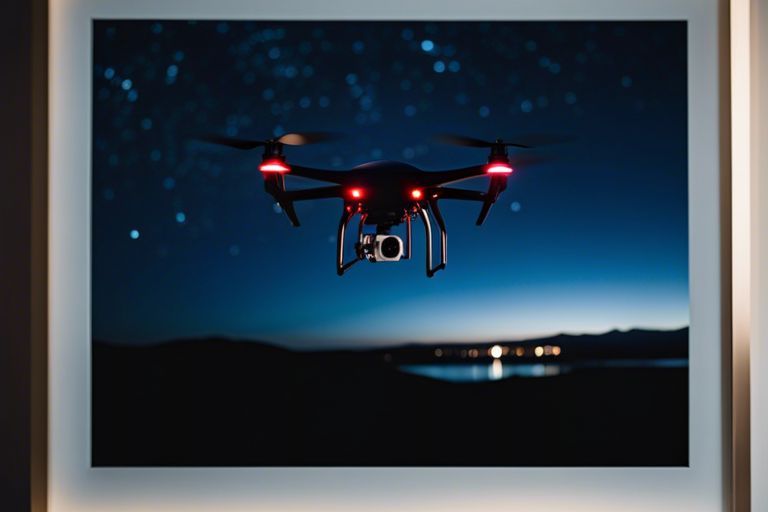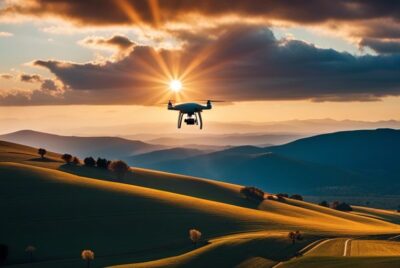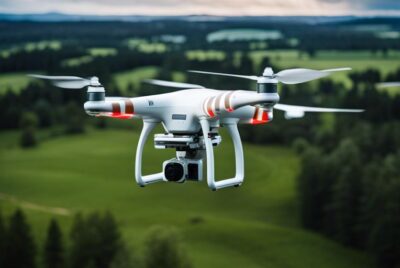“Nighttime Drone Photography – Illuminating the Dark Skies”
Photography enthusiasts and professionals alike are constantly seeking new and innovative ways to capture breathtaking images, and nighttime drone photography is a trend that is taking the photography world by storm. By harnessing the power of drones equipped with advanced lighting technology, photographers are able to illuminate the dark skies and capture stunning aerial shots that were once impossible to achieve. In this blog post, we will examine into the world of nighttime drone photography, exploring the equipment needed, techniques for capturing mesmerizing shots, and tips for making the most of this cutting-edge photography technique.
Understanding Your Equipment
For successful nighttime drone photography, it is crucial to have a thorough understanding of the equipment you will be using. From the type of drone to the camera settings, each component plays a vital role in capturing stunning nightscapes. In this chapter, we will explore into the essential aspects of your equipment for nighttime drone photography.
Types of Drones Suitable for Nighttime Photography
On your quest for the perfect drone for nighttime photography, it is essential to consider the specific features that cater to low light conditions. Here is a breakdown of some popular drones that are well-suited for capturing the beauty of the night sky:
| Drone Model | Key Features |
|---|---|
| DJI Mavic 2 Pro | Large 1-inch sensor for improved low-light performance |
| Autel Robotics EVO II | High-resolution camera with advanced low-light capabilities |
| Parrot Anafi USA | Extended ISO range for better performance in dark settings |
| Yuneec Typhoon H Pro | 360-degree rotating camera for versatile night photography |
| Autel Robotics Dragonfish | Specifically designed for low light and night-time aerial imaging |
Thou should also consider factors such as flight time, stability in windy conditions, and obstacle avoidance capabilities when choosing a drone for nighttime photography. The right drone will not only enhance your shooting experience but also ensure that your night shots are of the highest quality.
Camera Settings and Lenses for Low Light Conditions
An important aspect of nighttime drone photography is understanding the optimal camera settings and lenses for low light conditions. Setting your camera correctly can make a significant difference in the quality of your night shots. Some key camera settings to consider include:
To achieve the best results in low light conditions, it is recommended to use a wide aperture lens with a lower f-stop number. This allows more light to enter the camera sensor, resulting in brighter and clearer night images. Additionally, adjusting your ISO settings and shutter speed can help you capture stunning nightscapes with sharp details and minimal noise.
Techniques and Tips for Capturing the Night
Any photographer venturing into the realm of nighttime drone photography must be equipped with the right techniques and tips to successfully illuminate the dark skies. From scouting locations to mastering long exposure, here is a guide to help you elevate your nighttime drone photography game.
Scouting and Planning Your Nighttime Shoot
Any successful nighttime drone shoot begins with thorough scouting and planning. Before heading out, research potential shooting locations during the day to get a sense of the surroundings. Look for visually captivating elements such as city skylines, landmarks, or bodies of water that will translate well in the darkness. Consider factors like light pollution, weather conditions, and safety precautions before taking off into the night sky.
Recognizing the significance of pre-planning cannot be stressed enough. Create a shot list, determine the best time window for shooting based on the moon phase and weather forecast, and ensure you have all necessary permits and permissions if shooting in restricted areas. Be mindful of, preparation is key to capturing stunning nighttime drone photos.
Mastering Long Exposure and Noise Reduction
Shooters must understand the importance of long exposure and noise reduction techniques when stepping into nighttime drone photography. Long exposure allows for capturing light trails and creating mesmerizing effects in the night sky. Utilize the manual settings of your drone camera to control exposure time, aperture, and ISO to achieve the desired results.
Your post-processing workflow should include noise reduction techniques to eliminate graininess and produce clear, stunning images. Experiment with different noise reduction tools and software to enhance the quality of your nighttime drone photographs. Be mindful of, mastering these techniques will set your work apart and elevate your nighttime drone photography skills.
Recognizing the balance between long exposure settings and noise reduction is crucial in achieving professional-grade nighttime drone photos. Experiment with various combinations to find what works best for different lighting conditions and shooting scenarios. Consistent practice and a willingness to learn and adapt will help you refine your craft and capture breathtaking nighttime drone images.
Composition and Creativity in the Dark
Now, when it comes to nighttime drone photography, mastering the art of composition and creativity is key to capturing stunning shots in the dark. The night sky offers a unique canvas for photographers to play with light and shadows, creating dramatic and captivating images.
Framing the Perfect Nighttime Shot
Nighttime drone photography requires a different approach to composition than daytime photography. When framing your shot, consider the placement of lights, stars, and other elements in the scene. Experiment with different angles and perspectives to create depth and visual interest in your images.
For night shots, incorporating leading lines such as city streets, bridges, or shorelines can add a sense of movement and guide the viewer’s eye through the image. Don’t be afraid to get creative with framing – explore unique vantage points and perspectives to capture the essence of the night.
Utilizing Artificial Lighting and Creative Angles
Any nighttime photographer knows the importance of artificial lighting in creating visually striking images. Whether it’s using the drone’s built-in lights, light painting techniques, or incorporating external lighting sources, the possibilities are endless for illuminating the dark skies. By strategically positioning lights and experimenting with creative angles, you can add depth and dimension to your nighttime shots.
Creativity plays a significant role in nighttime drone photography. Experiment with different lighting techniques, angles, and perspectives to push the boundaries of traditional photography. Embrace the darkness as a blank canvas waiting to be filled with light, shadows, and your unique creative vision.

Post-Processing and Editing
After capturing stunning nighttime drone photography, the next step is post-processing and editing to enhance the images further. This crucial stage allows you to adjust exposure, fine-tune colors, and add creative touches to make your nighttime shots truly mesmerizing.
Adjusting Exposure and Colors for Night Shots
Nighttime drone photography often requires adjustments to exposure levels to balance the inherent darkness of the scene with the artificial light sources present. In post-processing, you can tweak the exposure to bring out details in the shadows without blowing out the highlights, achieving a well-balanced image. Additionally, playing with the color balance and saturation can significantly enhance the mood and atmosphere of your night shots.
Editing Software and Tools to Enhance Nighttime Images
Nighttime drone photography can benefit greatly from using specialized editing software and tools designed to handle the unique challenges of low-light situations. Programs like Adobe Lightroom and Photoshop offer a wide range of features specifically tailored for enhancing nighttime images, such as noise reduction, selective adjustments, and advanced color grading tools. These tools can help you bring out the best in your nighttime captures and make them truly stand out.
To make the most of your nighttime drone photography, investing time in learning how to utilize these editing software and tools effectively is crucial. Experiment with different techniques, explore tutorials, and develop your own editing style to take your nighttime shots to the next level. With the right post-processing approach, you can transform your raw nighttime drone images into captivating works of art that showcase the beauty of the dark skies.

Ethical Considerations and Regulations
Despite the allure of capturing stunning nighttime drone photography, it is crucial for drone operators to adhere to ethical considerations and regulations governing their flights. These guidelines not only ensure the safety of all individuals involved but also protect privacy and maintain compliance with local laws.
Understanding Privacy and Safety Laws
Ethical drone operation entails a thorough understanding of privacy and safety laws. When conducting nighttime flights, operators must be mindful of trespassing laws and regulations concerning capturing images or footage of individuals without their consent. Additionally, ensuring the safety of bystanders and property is paramount, requiring operators to maintain a safe distance from people and buildings.
Understanding the legal implications of flying drones at night is essential. Regulations may vary from one location to another, with some areas imposing restrictions on nighttime drone flights to safeguard public safety and privacy. It is imperative for drone operators to stay informed about the specific laws and guidelines applicable to their chosen flying locations.
Flying Etiquettes and No-Fly Zones
To promote responsible drone operation, adherence to flying etiquettes and respect for designated no-fly zones is non-negotiable. These guidelines are put in place to prevent potential hazards, protect sensitive areas, and mitigate disturbances to wildlife and communities. Prior to each flight, operators should verify the designated no-fly zones and plan their routes accordingly.
Flying in a considerate and respectful manner not only fosters a positive image of drone enthusiasts but also contributes to maintaining the integrity of the aerial photography community. By following flying etiquettes and respecting designated no-fly zones, operators can enjoy their nighttime drone photography pursuits while upholding ethical standards and legal compliance.

Final Words
With this in mind, nighttime drone photography has emerged as a powerful tool for capturing the beauty of our world after the sun sets. By using drones equipped with the latest technology, photographers can illuminate the dark skies and create stunning images that were once impossible to capture. The versatility and creativity that nighttime drone photography offers are unmatched, allowing artists to push the boundaries of their craft and showcase the world in a whole new light. As technology continues to advance, we can only imagine the incredible images that will be captured and the stories that will be told through this innovative form of photography.



